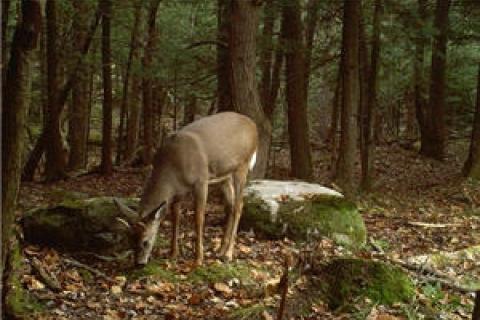
Stand placement is always a tricky thing. So many deer hunting factors need to come into play.
One important thing I’ve learned over the years is to try to visualize what you will have to consider on the stand at the time of day and part of the season you want to use it.
 |
| While this is clearly a good place for deer, the cedars mean that treestands cannot be too high or visibility is affected. |
With that in mind, here are a few key things to consider before setting up any treestand or ground blind.
1. Wind direction — This is clearly the most important thing when setting up any stand. No matter how many scent blocking precautions you take, it’s simply no good if the wind is blowing from you to the animal. And while wind direction is fairly straight forward, thermals are something a lot of hunters forget to consider. Simply put, thermal air currents rise in the morning and fall in the evening so include that knowledge in your planning, too.
2. Whether the treestand will be used in the morning or evening — This is important because in the former case, you’ll deal with sunrise and in the latter, sunset. Knowing this, you can set up so you don’t stare into the sun while waiting for an animal. Aside from being hard on your eyes, it also means the deer is walking into your position while you are lit up by sunshine.
3. Foliage — You also need to consider how much of the leaf cover will be up when you hunt. In early fall, there’s lots, of course. This influences how far you can shoot, whether shooting lanes need to be cut, how high you place a treestand, and where you place a ground blind. In the late fall when leaves are down, you might find those same stands are too exposed while shooting lanes are not an issue at all.
4. Typical wind velocities — I’ve hunted in treestands set in places where the wind rocked the trees viciously all the time. I would have been better off in a ground blind in those situations. When a tree is constantly swaying, you’re not comfortable and not apt to make your best shots either.
5. Escape cover and how hard a drag it will be — Some places are great for hunting and horrible for deer recovery. For instance, I know one marshy area where deer are thick, but I’d never hunt there. I’m sure the minute I arrow one it will go straight to the most inhospitable watery places God ever created – dragging one out of there would be hell. I’d rather hunt 100 yards or so away from that core area and hope they die before they make it in.
These are a few things to consider when thinking about where you’ll place your stand. Give this some thought before you set up, and you’ll save yourself a lot of trouble.
For more advice on treestand placement, visit Are You Making These 3 Mistakes When Positioning Deer Stands? at Bass Pro Shops 1Source.
- 5782 views

